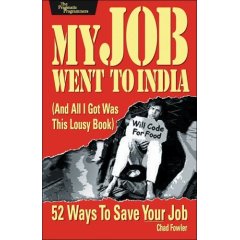 Despite the alarmist title, I loved this book. The author, Chad Fowler, spent a year and a half in India setting up his company’s new software development center. Chad’s task was to interview and select 25 people who would form the “seed team” of a development shop that would eventually employ 250 people. The book contains his thoughts on the steps you need to take to ensure your job is not one of the many IT jobs that are moving over seas. Because of his experience there he is in a good position to expound on the differences between IT services performed here and abroad.
Despite the alarmist title, I loved this book. The author, Chad Fowler, spent a year and a half in India setting up his company’s new software development center. Chad’s task was to interview and select 25 people who would form the “seed team” of a development shop that would eventually employ 250 people. The book contains his thoughts on the steps you need to take to ensure your job is not one of the many IT jobs that are moving over seas. Because of his experience there he is in a good position to expound on the differences between IT services performed here and abroad.
There are 52 bite sized chapters that are usually around 2-4 pages each. Its very easy to get through this book, the small chapters make it easy to read just a few pages whenever you can find time. Most chapters end with an “Act on It!” section where Chad gives you a short list action items that will help you implement the topic of the chapter.
Some of my favorite chapters are:
Chapter 2, Coding Don’t Cut it Anymore
This chapter discusses that we need to be more than “just programmers”, we need to have an understanding of the business we work in. For example, if you work for Enterprise, you’ll be a more successful programmer/DBA/whatever if you have an understanding of the vehicle rental business. I’ve experienced this personally at CF WebTools. Several of the developers here have previous experience working at a company that provides financial data. This has given us an edge in gaining several clients that have financial based websites.
Chapter 5, Be a Generalist, expands on the “not just a programmer” theme. General programming jobs (here’s the design, now make code out of it) will be the likely jobs outsourced. It’s wise to invest time in learning database administration, server operating systems, interface design, etc.
Chapter 16, On the Shoulders of Giants
This one talks about learning from the leaders in your profession. Read their blogs, download their code and go through it, and join them in conversation at conferences. A side benefit of this is when you need a particular piece of functionality in your app, you may be able to contribute – “I saw that so and so already has a component out there to do that, lets use it and save us ourselves some time.” Closely related is chapter 41, Making the Hang, which goes into more detail about the benefits of getting to know the key players in your chosen technology.
The last third of the book is about marketing yourself, specifically in how you deal with customers, managers and coworkers. There was some great stuff here.
Overall this is one of my favorite career books, and I’m looking forward to reading it again.
The book is very reasonably priced, and available at Amazon.com.

